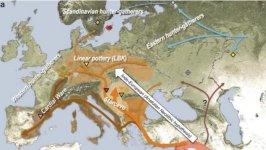I don't understand this dispute over J2. We've been over this in other threads.
http://www.eupedia.com/forum/thread...asin-356-pages?p=461135&viewfull=1#post461135
"The J2 was from 4990-4850 BC. One was found in Lengyel and one in Sopot culture." These are
Neolithic cultures. Ipso facto, J2 was in Europe by the Neolithic. I don't think you can even call it late Neolithic, although that would be nice for me because that's in line with what I had predicted.
Now it seems the argument has moved on to whether
most of it came in the Bronze Age instead of the Neolithic. I have no idea how one could make that determination. We don't even know yet whether it was J2a or J2b, do we?
Perhaps it will turn out that it was J2b, and, to quote myself...
"The question remaining is were J2 and E-M78, for example, present in the earliest Neolithic in the southern most regions of Europe, and just didn't move north until later, or were they a slightly different Neolithic population that entered even southern Europe slightly later than G2a?"
This is what the author of the paper has to say:
"The three new NRY, J, C, and Eb1b1a signalize new population elements in the Sopot community, which subsisted during and after the Lengyel period of the region as well."
"It's difficult to define the origin of these new components..."
If this was a second wave of the Neolithic, perhaps it consisted of people like those represented by the new Neolithic Anatolian sample found near the remains of Troy (but preceding it). The abstract indicated it was slightly different from the early European farmers. Hopefully those results will soon be released and they will be able to find some yDna.
Of course, some J2 no doubt also came to Europe during the Bronze Age, perhaps particularly J2a. It seems to have had a different trajectory into Europe, sort of bypassing northern Greece. When did it get to Crete? I think that was a way station. The answer to that question will explain a great deal.
We don't
know the relative percentages of how much came when,(although samples in the pipeline may give us clues) and honestly, who cares other than as a matter of intellectual curiosity?



